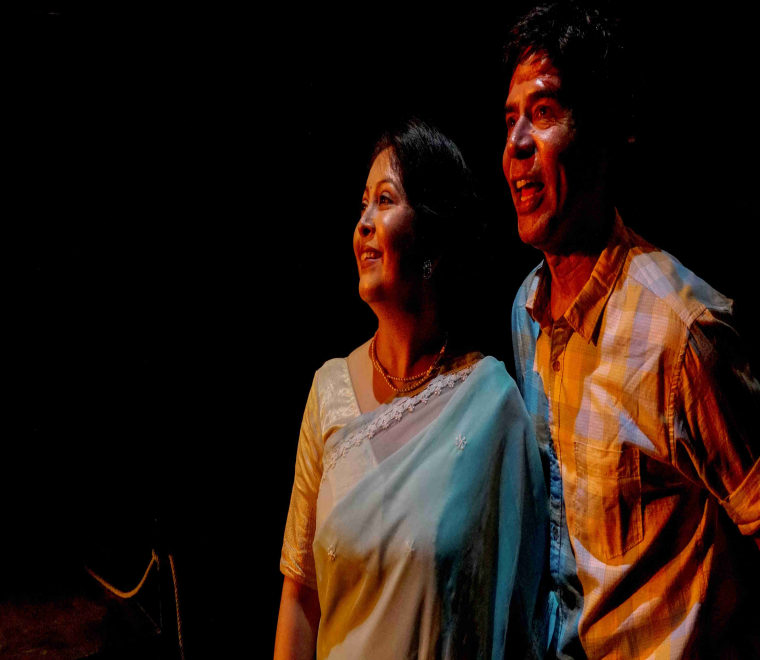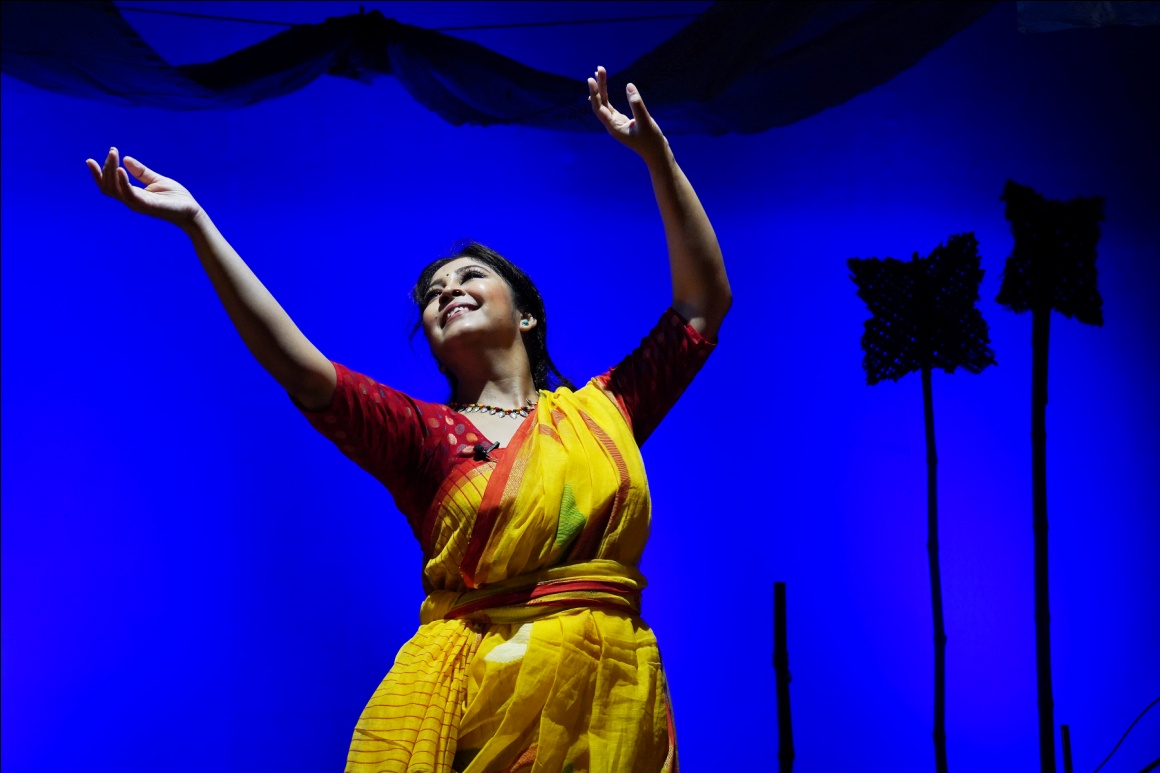Reviews
Reviews by some of the revered newspapers
Sojan Badiar Ghat
২৫ বছর পর গৌতমের হাত ধরে ফিরছে ‘সোজন বাদিয়ার ঘাট’
মাঝে কেটেছে প্রায় ২৫ বছর। আরও একবার জসীম উদ্দীনের জনপ্রিয় কাব্য ‘সোজন বাদিয়ার ঘাট’ কে মঞ্চে ফিরিয়ে আনছেন নির্দেশক গৌতম হালদার। ‘নয়ে নাটুয়া’র ১৫ বছর পূর্তি উপলক্ষে এই সিদ্ধান্ত নিয়েছেন তিনি। নাটকের শেষ মুহূর্তের মহড়ার মধ্যে পাওয়া গেল গৌতমকে। সোজন ও দুলিকে কেন্দ্র করে ফিরে গেলেন শৈশবের স্মৃতিতে। বললেন, “ছোটবেলায় এক আত্মীয়ের থেকে উপহার পাওয়া ক্যাবটা পড়ে তখন খুব একটা বুঝতে পারিনি। কিন্তু তিন দশক আগে পড়ে বুঝতে পারি তার অন্তর্নিহিত অর্থ। সেই ভাবনা থেকেই একসময়ে ‘নান্দীকার’-এ ‘সোজন বাদিয়ার ঘাট’ নাটকটা মঞ্চস্থ করি। সেই সময় নাটকে সোজন ও দুলির চরিত্রে অভিনয় করেন যথাক্রমে গৌতম ও সোহিনী সেনগুপ্ত। সামগ্রিক পরিকল্পনায় ছিলেন গৌতম নিজেই। গৌতম বললেন, “রুদ্রবাবু(রুদ্রপ্রসাদ সেনগুপ্ত) নিজে নায়েবের চরিত্রে অভিনয় করেছিলেন। সোমবার আমাদের প্রথম শো দেখতে রুদ্রবাবু নিজে আসছেন। এটা আমার কাছে একটা বড় প্রাপ্তি”।

এই নাটকের প্রেক্ষাপটে হিন্দু-মুসলমান সম্পর্ক। গৌতম মনে করেন, এই সোজন এবং দুলির আখ্যান আজও সমাজে সমান ভাবে প্রাসঙ্গিক। তাই বর্তমান সময়ের কথা মাথায় রেখেও ফিরে আসছে এই নাটক। তাঁর কথায় “সমসময়ে এমন একাধিক ঘটনা আমরা দেখেছি। আমার তো মনে হয়, এই গল্প এখনও দর্শকের মন জয় করে নেবে”। পাশাপাশি জানালেন, দর্শকের থেকেও এই নাটক নিয়ে বহু বার তাঁর কাছে অনুরোধ এসেছে। এ বারে গৌতম নাটকে একাধিক পরিবর্তন করেছেন। সোজন-দুলির ছোটবেলা যেমন থাকছে,তেমনই অভিনয়ে শরীরী ছন্দের উপর জোর দেওয়া এবং নাটকে সঙ্গীতের ধরনও বদলেছেন তিনি।

এ বারে নাটকে সোজনের চরিত্রে রয়েছেন গৌতম এবং দুলির চরিত্রে রয়েছেন দ্যুতি হালদার। দুটি ভিন্ন সময়ে একই চরিত্রে অভিনয় করতে গিয়ে মনের মধ্যে কী চলছে গৌতমের? হেসে বললেন, “থিয়েটারই তো আমাকে বাঁচিয়ে রেখেছে। নাটকে এ বারেও লাঠি খেলব।
Doosra
আদর্শ প্রেমের অন্বেষণ কি সম্ভব? নতুন নাটকে প্রশ্ন গৌতমের, ‘দুসরা’য় কী কী চমক থাকছে?
‘নয়ে নাটুয়া’র নতুন নাটক ‘দুসরা’। নেপথ্য ভাবনা ভাগ করে নিলেন নির্দেশক গৌতম হালদার
সার্থক ভালোবাসার সন্ধানে ঘোরে মানুষ। কিন্তু, তা কি সম্ভব? ভালো–মন্দের মিশেলেই জীবন। তাই আদর্শ ভালোবাসা ‘অলীক’–ই বটে। সার্থক ভালোবাসার অন্বেষণে দম্পতির জীবনে কি কি বাঁক আসে, তা নিয়েই ‘নয়ে নাটুয়ার’ নতুন নাটক ‘দুসরা’। স্লোভেন সাহিত্যিক এভাল্ড ফ্লিসারের লেখা ‘দ্য নিম্ফ ডাইজ’ অবলম্বনে তৈরি এই নাটকের নির্দেশক গৌতম হালদার। হঠাৎ এই ধরনের নাটক বেছে নিলেন কেন গৌতম? গৌতম বললেন, “সমাজে প্রতিনিয়ত ‘কর্পোরেট’ জীবনযাত্রার প্রভাব বাড়ছে। বিষয়টা নিয়ে একটা নাটক করার ইচ্ছে ছিল দীর্ঘ দিনের, তারপর এই নাটকটা পছন্দ হয়।” গৌতম জানালেন, মূল নাটকের নির্যাস বজায় রেখেই কাহিনীতে বাঙালিয়ানা প্রবেশ করানো হয়েছে। নাট্যরূপ দিয়েছেন রতনকুমার দাস।
গৌতম জানালেন মূলত নাটকটি অ্যাবসার্ড ঘরানার। তবে সেখানে স্যাটায়ারও রয়েছে। সেখানে থাকছে ‘রামায়ণ’– এর প্রসঙ্গও। নাটকের কুশীলব চারজন। এক সদ্য বিবাহিত দম্পতি, বস এবং আদিকবি। দম্পতির চরিত্রে অভিনয় করছেন পার্থিব রায় এবং দ্যুতি ঘোষ হালদার। বসের চরিত্রে গৌতম এবং আদিকবির চরিত্রে রয়েছেন স্পন্দন বন্দ্যোপাধ্যায়।
সদ্য বিবাহিত স্বামী–স্ত্রীর বৈবাহিক জীবনে একটাই দুঃখ– তারা কোনও দিন মধুচন্দ্রিমায় যায়নি। নেপথ্য রয়েছে স্বামীর বস। এক সময়ে বসের সঙ্গে স্বামী কর্মসূত্রে দণ্ডকারণ্যে স্থানান্তরিত হয়। দম্পতি কি হানিমুনে যাবে, না কি তাদের জীবনটা বনবাসে বদলে যাবে? শেষে কোন জীবনসত্য উদঘাটিত হবে, নাটকটি তার উত্তর দেবে। আগামী ৩০ অগস্ট মধুসূদন মঞ্চে ‘দুসরা’র প্রথম শো।
আনন্দবাজার অনলাইন
২৬ অগস্ট ২০২৪
Audience Reaction After watching Naye Natua’s Production Doosra
একটি সুন্দর উপস্থাপনা, আগামী ৮ই সেপ্টেম্বর দুপুর ৩টে অ্যাকাডেমিতে এই নাটকটির পরবর্তী অভিনয় আছে শুনলাম। আবার যাবার ইচ্ছে আছে। যে নাটক মুগ্ধ করে, যে নাটক মন ভালো করে সেই নাটক দেখার জন্য সময় বের করে হলে পৌঁছে যাওয়া যায়।

Mitali
DOSTOEVSKY CLASSIC DRAMATISED IN BENGALI
The play unfolds in a monologue that introduces the story in a first personal narrative spouted by no other than Goutam Halder himself, who recalls memories of his days in close proximity with his old flame Mitali, fleshed out by Dyuti Ghosh Halder. Halder then makes a volte-face with a change of wigs from white to black to journey down memory lane captured in the flashback sequences, which take up a sizable amount of footage and almost the entire length of the play. This is to create an illusion of the past and an escape from the ground realities of the decadence of his ageing persona.
The monologues and interactions between the actors on stage provide ample opportunities to prove their virtuosity. As the white-haired old man metamorphosed into his youthful days, Halder excelled as an actor with an elephantine memory that came to his rescue as an actor, though in his neurotic overexcitement both during the monologue and the interactive exchange of dialogues, his utterances occasionally became garbled. His better half, Mitali, enacted by Dyuti Ghosh Halder while recounting her narrative of her bitter days of privation and her final reconciliation with her lover, was convincing with a show of emotion in her monologues. However, when all is said and done, it was a commendable effort to introduce Dostoevsky to a Bengali audience unfamiliar with his works. Music formed part of a background score, including some Bollywood oldies and the Tagorean Sanskritic lyrics complement the production. However, some Western music would not have been out of place to augment the mood and pace.
ANIT MUKHERJEA
THE STATESMAN

Nakshi Kanthar Math
RUSTIC CHARM
In this Naye Natua production, Halder starts from scratch and directs a small team of young actors supported by seasoned music accompanists led by Satyajit Chowdhury on the violin. The director takes charge of all the major departments like stage, light and music. The rustic nuances of Jasim Uddin’s 1929 publication were not compromised and Halder’s signature was unmistakable all over the Academy of Fine Arts auditorium on February 6. Most importantly, he casts Dyuti Ghosh Halder as the sole narrator taking the centrestage flanked by two sets of supporting actors- male and female. The tale of two villages set apart by a field was denoted by simple bamboo pole arrangements on either side of the proscenium. Two small puppets standing for Rupai and Saju- the star-crossed lovers added to the ethnic charm. Although the costumes looked too crisp and colourful for the subject, and the all-important kantha missed the regional look, the 125-minute-long production rode smoothly on Ghosh Halder’s broad shoulders. This multi-talented actor breached the fourth wall in no time, took the audience into confidence, switched roles with commendable finesse and never let the tempo fall. Halder makes ample use of her singing voice that registered pathos at regular intervals.
ANSHUMAN BHOWMICK
THE TELEGRAPH

Moimonsingha Gitika
FOLK FLAVOUR
The Moimonsingha Gitika (more accurately Palagan, the performance genre to which they belong) form the source for two invigorating Bengali productions. Naye Natua’s eponymously titled show has even made it to the Mahindra Excellence in Theatre Awards, Delhi, next week, the lone Calcutta group to reach the finals. Moimonsingha Gitika is a misnomer, though, because Goutam Halder dramatizes only one of the stories in Dinesh Chandra Sen’s collection, that of Mahuya by Dwija Kanai- relevant to our bigoted times since the Brahmin girl in the Garo Hills. Kidnapped and raised by the Bede, Humra, falls in love with prince Nader Chand.
Halder has also directed, choreographed and composed live music, a versatile accomplishment. But unlike his early success Meghnadbadh Kabya, this is not a one-man show. On the contrary, he commendably detaches himself from the stage as the narrator cultivating an objective distance and tone, often pacing the aisles while his large team theatricalizes the action. Dyuti Ghosh Halder stands out as a spirited Mahuya, but all contribute to a colourful- even unrealistically exotic- and power-packed presentation with hardly a moment’s stillness.
ANANDA LAL
The Telegraph

Othello
Goutam Halder’s direction extracts uniformly good supporting performances and contains moments of unusual space utilization: the first scene moves from the auditorium (Iago and Rodrigo) to the forestage (Brabantio), the curtains then parting for Othello’s dramatic entry, with deeper upstage alcove behind an arch.
Dyuti Ghosh Halder gives Desdemona her vulnerability and also designs tasteful costumes and Swajan Srijan Mukherjee creates a perfect gull of Roderigo.
ANANDA LAL
The Telegraph

Lakshmir Pariksha
GOUTAM DOES A CHAPAL BHADURI
About choosing an unusual subject and far more queer character, Goutam says, “It is a hilarious comedy at the beginning of which, Kshiro, a housemaid, resents her plight and the way of the world that usurps the labour of the poor to fatten the rich. I play Kshiro. The theatrical elements in the play made me choose it and explore it further. Also, I haven’t seen any group perform Lakshmir Pariksha before.” Playing a woman isn’t easy. But Goutam, who is also directing the production says,” Kshiro is wicked and selfish. The manliness in her physicality stands out. But even then it is a difficult role. Though I am certain that my impersonation of a woman can never be at par with Chapal Bhaduri’s, I have tried my best.”
ZINIA SEN
Calcutta Times

Missed Call
WRONG NUMBER
Missed Call, the play written by Debshankar Halder and directed by Goutam Halder, critiques our preoccupation with the handy communication tool, mobile. The three-member cast features brothers Laltu(Goutam) and Rony(Debshankar) trying to fight parental and societal pressure by communi-faking, along with their doctor in charge (Dyuti Ghosh Halder).
Laltu and Rony have not been allowed to live the life of their dreams, so they live in their dreams. The presentation is abstract, with an interesting use of role reversal. The tone of comedy persists even when the performers recite serious poetry and comedy becomes an affront.
T2, THE TELEGRAPH

Nana Range Rabi
REAL MAGIC AND A BROKEN SPELL
Naye Natua’s collage Nana Range Rabi, revives seven of the fifteen Hasyakautuk. Normally the preserve of school functions, they lend themselves to children’s theatre, so Naye Natua justifiably marshals its youngest trainees into the enactment of Chhatrer Pariksha, Roger Chikitsa, Abhyarthana, Pete o Pithe and Bhab o Abhab interspersed with dramatizations of such poetic warhorses as Talgachh, Brishti Pare Tapur Tupur, Dui Pakhi and the ubiquitous Birpurush.
There are no surprises there except for the supercharged energy levels that Goutam Halder directed them into. After the interval, however, the real magic occurs. The performance involves adult members doing hilarious turns in the plays. The dancers, led by Dyuti Ghosh Halder, also sing simultaneously using Kathakata storytelling styles and experimenting with hybrid choreography from Kathak to Western, taking Tagore’s own syncretic methods further.

